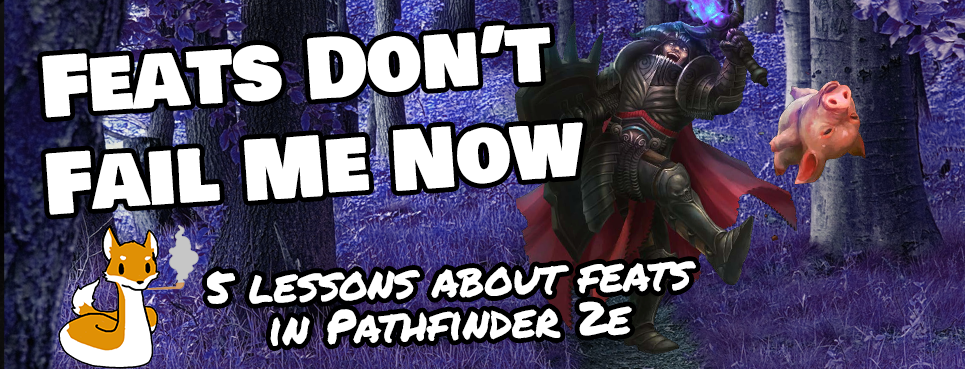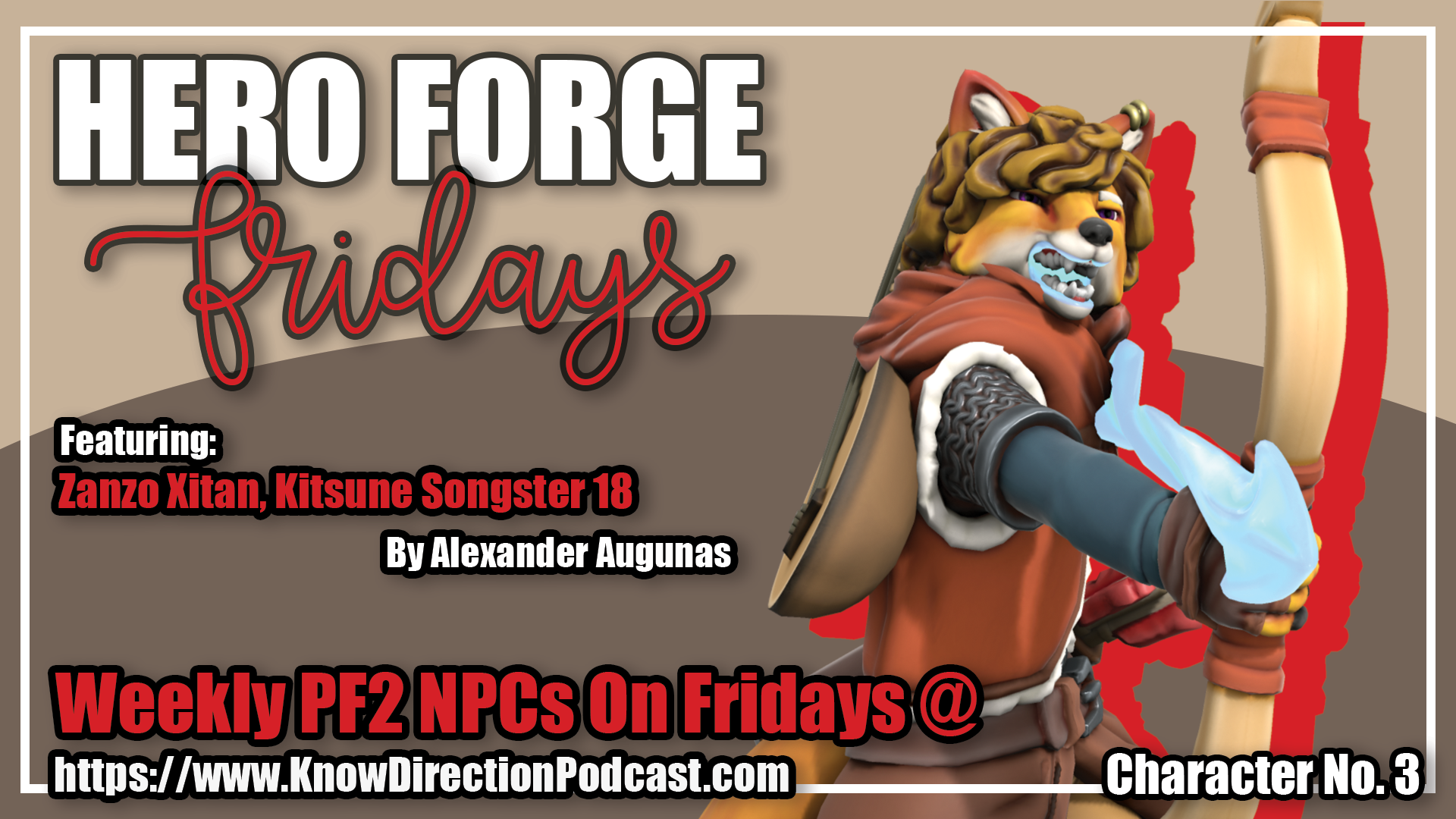If you are on this blog you probably already know what a feat is: A special talent or attribute for your character! Feats weren’t always a thing in Roleplaying Games; It wasn’t until the year 2000 that we got these customizable little nuggets we could apply to any PC. We had proficiencies and fighting techniques as far back as 1990, but they were always tied to faction specific prestige classes and always felt more like Class Archetypes. It wasn’t until 2000 that we got general feats any character could take, and even then it wasn’t until significantly later that games began to downplay class features in lieu of a talent-like feat system that would lead to the system we all know and love today. Huh. 2000 feels new and shiny, and yet in just 4 years we will be able to say that feats have been around for a majority of our hobby. Oh no: I’m old!
Existential mid-life crisis aside, I’m here to talk to you about feats! Specifically, I want to share a four lessons I’ve learned about feats in Pathfinder Second Edition that you might want to keep in mind next time you sit down to decide what feat you’re going to take next.
Lesson 1: Higher Level≠(Much) Higher Power
Taking the highest level feat is not always the best choice for a character. I too tend to look at my highest level options because I want to make sure there isn’t some power that I might not ever get to use again, and that kind of fear-of-missing-out is a perfectly valid way to choose your feats; If you’ve always wanted to fulfill a certain fantasy and it requires an 18th level class feat, go ahead and pick the feat. After all, you may never reach 18th level with this class again! That being said, there is nothing wrong with picking a lower level feat using a higher level feat slot! Most level 1 feats are just as useful at level 20 as they are level 10! In fact, there are many lower level feats that are better at higher levels, like certain metamagic feats you might want paired with higher level spells, or trapfinding (seriously, higher level hazards can be way more dangerous). Feats having specific levels helps quickly generate characters taking standard paths of progression as many classes have semi-clear “paths” and having the feats at different levels helps players see the optimal progression for that style of play with that class. For example, a Ranger using a bow might notice that there is exactly one feat at every level that specifically works with archery: Hunted Shot at level 1, Hunter’s Aim at level 2, Far Shot at level 4, Snap Shot at level 6, etc… and starting with that load-out of feats when using that style of character and then deciding which feats just don’t quite work for you is a perfectly valid way of building a character…but don’t worry if you want both Hazard Finder and Deadly Aim at level 8 in a hazard-heavy campaign: You can just take one of them at level 10!
Now this general rule has tons of exceptions, and naturally feats that would irrevocably alter how the game is played at lower levels are regulated to higher level slots. Likewise there are some very powerful feats at higher levels, especially those capstone feats. But the best way to remember that lower level feats are still worth it is noting how many solid Multiclass Dedication builds want those “half your character level” feats!
Lesson 2: More Feats≠(Much) More Power
I’ve played and run tons of games using the core rules, free archetype variant rules, and even a new variant rule I’ve been testing that adds both a free archetype and a number of other bonus feats based on a character’s background. And guess what? The same level threats are just as threatening! Pathfinder 2e characters go “wide”, meaning feats give them more things they can do much more often than they give them things they can do better. While it’s possible to min-max on feats that only give you more and more bonus damage, ultimately you’ll do better and are way more likely to be picking feats that instead offer you a wider variety of answers to common threats and different actions you can choose each round. I’ve even heard of games where characters get every ancestry feat they qualify for and apparently it hasn’t affected the balance of the game because ultimately feats rarely bump numbers too far beyond expected parameters.
Another great example of this is the Spell Trickster archetype. Go ahead and read the third paragraph of the “The Fruits of Research” sidebar. Feats can be offered as a reward or story element to a dedicated character, a reward for an adventure, a gift from a notable power, or just influence from a magic plane. Now Spell Tricks are an outlier in that the nature of the dedication feat proves they tend to be worth “half-a-feat” (at least the level 4 ones), but the truth is this can apply to a multitude of feats depending on the character, the party, and the campaign! I’m not saying that every player should have access to every feat they qualify for…I’m just saying you shouldn’t expect that party to suddenly be able to breeze past Level+4 encounters, given…
Lesson 3: Wide Power=(Much) More Depth
Almost every feat in Pathfinder 2e is valid. Some people disagree, but even the worst class feats are way better than the worst 1e feats or 3e feats or 5e feats. And that’s because very few 2e feats add stacking bonuses and while some will reduce penalties there are fewer penalties in general for your typical adventurer than in most older game systems. What this means is you can pick whatever feat you qualify for that would “fit your character” and still (probably) have the same odds of contributing to the defeat of a threat of the same level. Now this isn’t always the case in every campaign: Recently Hiyori in my Where There’s Smoke firefighter’s of Absalom campaign got a feat that let them convert their Foxfire to cold damage, which has been immensely useful in a dungeon full of enemies who are immune to fire! And some people would argue that not being able to stack lots of bonuses to always be better than anyone else at one specific specialization makes specializing as a character impossible, to which I will always point them to the Wrestler archetype! Sure, getting five feats that say “+2 to Athletics when using Grab” sounds great; You’ll be able to Grab anything! But isn’t it more fun to instead get 5 different moves you can use with Grab? After all, if you don’t like a chance of failure why are you playing a game with dice? And if you ask me, the grappler who has 5 interesting ways to grapple has more depth than the grappler who is 50% more likely to successfully grapple someone.
Lesson 4: Skill Feats≠(Much) Fewer Options
Back in the day I used to hear from people who’d claim Battle Medicine, Intimidate, and Athletics were the only skill feats worth investing in. I didn’t buy it then, and I’m seriously not buying that now. Incase you didn’t know, there’s been lots of new skill feats release since the Core Rulebook. You can find the Secrets of Magic and Advanced Player’s Guide skill feats on the Archives of Nethys skill feat page, but you should also check out the 72+ incredible Archetype Skill feats, as they are nothing to sneeze at and more than just “easy ways to bypass a dedication requirement”. There are also plenty of great skill feats from Third-Party sources, including Pathfinder Infinite and Everybody Games (shameless plug to my own work here). Skill feats can even be a great source for early level Reactions for classes that don’t always get them.
Lesson 5: Feats≠(Much) More Permanent
For the first two decades of d20 “builds” were absolutely critical. You had to qualify for your prestige classes and higher level feats by taking “taxes” of lower level feats, and once you picked a feat it was often a permanent choice. There were spells and optional sub-systems that let you change your feats, but they were considered “broken” and banned at most tables as they let you pick powerful feats at lower levels and switch those to “tax” feats to qualify for higher level powers. This is far less of a thing now, and the wider margin of power in 2e makes retraining feats not only balanced, but a core mechanic of the game. I myself run a fairly tight ship with how I track my downtime, using an in-character calendar that tracks each player’s activities, and yet I still don’t really care when a player wants to change around their load-out of feats. It honestly makes sense that a character should be allowed to try a feat before they “buy it” anyway, and oftentimes they can find that something they learned how to do might just not work the way they thought it would on paper. How often have you crammed to learn something for a new job only to learn you didn’t actually need to use it? Do you still know how to do that thing without needing a refresher? You may or may not, but you’ll probably agree with me that it’s not crazy that some people can’t. Now if you’d rather have a system in place to let players try feats before they commit, I do have a full set of variant rules on incremental advancement. But even using that, I wouldn’t outlaw retraining!






